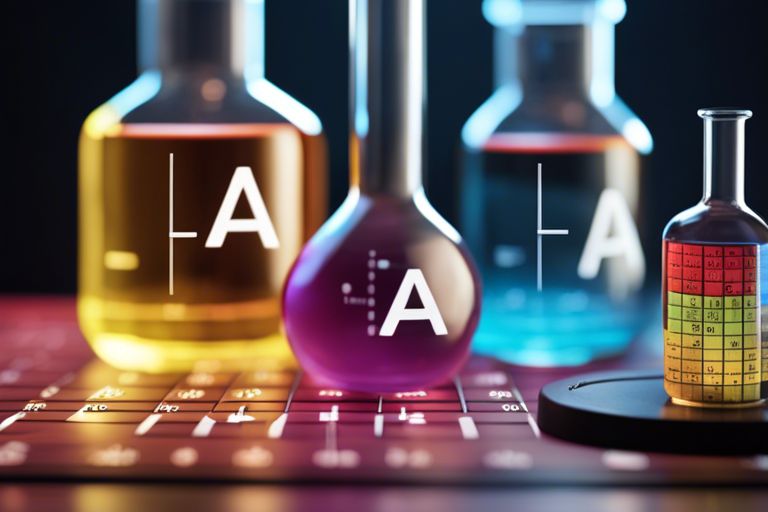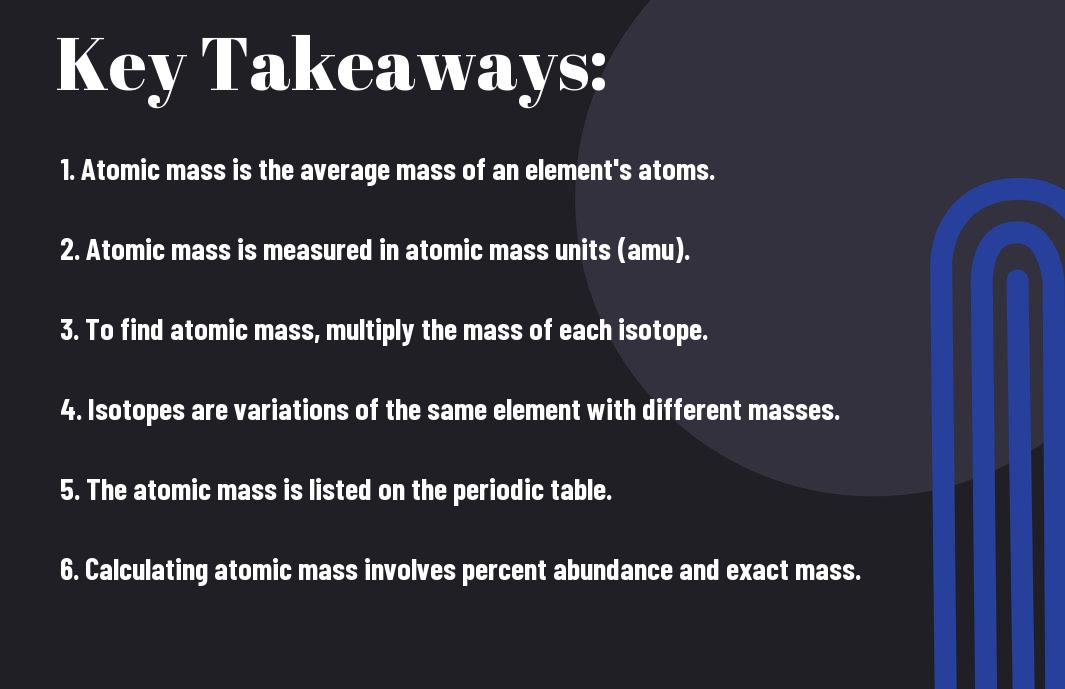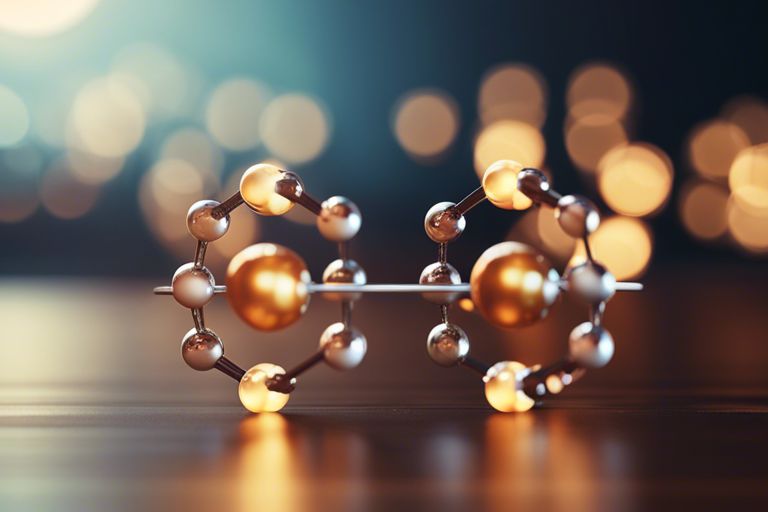Thoroughly understanding the concept of atomic mass is crucial for anyone hoping to excel in the field of chemistry. Atomic mass is a fundamental concept that is used to calculate several important chemical quantities, such as molar mass and molecular weight. In this blog post, I will break down the process of finding an atomic mass in a simple and understandable way, equipping you with the knowledge and tools necessary to succeed in your chemistry studies. By the end of this post, you will be able to confidently calculate the atomic mass of any element, accurately interpreting the composition and properties of different substances.
Key Takeaways:
- Atomic mass is the average mass of an element’s atoms, taking into account the different isotopes and their abundance.
- The periodic table provides the atomic mass of each element, typically listed below the element’s symbol.
- To calculate the atomic mass of an element with multiple isotopes, multiply the mass of each isotope by its abundance and then sum the values together.
- The unit of atomic mass is the atomic mass unit (amu), which is defined as one-twelfth the mass of a carbon-12 atom.
- Understanding the concept of atomic mass is crucial in chemical calculations and understanding the properties of elements.
Understanding Atomic Mass
A fundamental concept in the field of chemistry, atomic mass refers to the mass of an atom of a chemical element. Understanding atomic mass is crucial to comprehending the behavior and properties of elements, and it serves as a cornerstone for various chemical calculations and experiments.
Definition of Atomic Mass
Atomic mass is defined as the average mass of all of the isotopes of an element, with each isotope’s mass being weighted by its abundance. It is usually expressed in unified atomic mass units (u) and is measured using a mass spectrometer.
Importance of Atomic Mass in Chemistry
The concept of atomic mass is of great significance in chemistry. It directly impacts the stoichiometry of chemical reactions, as it determines the amount of substance in a given sample. Furthermore, the atomic mass is crucial in the determination of the molar mass of compounds, which is essential for various calculations such as percent composition, empirical and molecular formulas, and limiting reactant problems. Additionally, atomic mass plays a pivotal role in the identification of unknown elements and compounds.
Methods for Finding Atomic Mass
Obviously, finding the atomic mass of an element is a crucial aspect of understanding its behavior in chemical reactions. There are several methods for determining the atomic mass, including using the periodic table and calculating atomic mass from isotopes.
Using the Periodic Table
When using the periodic table to find an element’s atomic mass, you can look at the average atomic mass listed for each element. This average takes into account the relative abundance of each isotope of the element. The atomic mass is listed below the element’s symbol on the periodic table. It is important to note that the atomic mass listed is in atomic mass units (amu). It is a simple and convenient method for finding the atomic mass of an element.
Calculating Atomic Mass from Isotopes
Isotopes are atoms of the same element that have a different number of neutrons. To calculate the atomic mass of an element from its isotopes, you need to know the percent abundance of each isotope and its respective atomic mass. By multiplying the percent abundance by the atomic mass of each isotope and adding the results together, you can find the atomic mass of the element. This method provides a more precise atomic mass value based on the specific isotopic composition of the element.

Applications of Atomic Mass
Now that we understand how to find an atomic mass, let’s explore some practical applications of this important concept. If you’re interested in diving deeper, I recommend checking out 3 Ways to Calculate Atomic Mass for more detailed information.
Determining Molecular Formulas
When determining the molecular formula of a compound, knowing the atomic mass of each element is crucial. By adding up the atomic masses of the elements present in the compound, you can calculate the molecular mass. This information is essential for understanding the composition of a substance and its chemical behavior. It allows you to predict the behavior of the compound in different reactions, helping you make informed decisions about its usage and handling.
Understanding Chemical Reactions
Understanding atomic mass is fundamental to comprehending chemical reactions. When substances undergo chemical reactions, the atomic mass plays a critical role in determining the quantity of each element involved. This knowledge helps you predict the outcome of a reaction, identify the limiting reactant, and calculate the yield of a product. Understanding the atomic mass of each element involved in a reaction is essential for effectively conducting experiments and ensuring safety in the laboratory. It also allows you to optimize reaction conditions and minimize the risks associated with handling reactive substances.

How to Find an Atomic Mass – Basics of Chemistry
Taking this into account, understanding the basics of finding an atomic mass is essential for any student or enthusiast of chemistry. By utilizing the three different methods of finding atomic mass – using the periodic table, using isotopic composition, and using mass spectrometry – you can confidently determine the atomic mass of an element. That knowledge is crucial for various chemical calculations and understanding the behavior of elements. For more in-depth information on this topic, you can refer to this informative article on How to Find Atomic Mass – 3 Different Methods.
FAQ – How to Find an Atomic Mass – Basics of Chemistry
Q: What is atomic mass in chemistry?
A: Atomic mass is the mass of a single atom of a chemical element. It is typically measured in atomic mass units (amu) and is an important concept in chemistry for understanding the properties of elements and their compounds.
Q: How is atomic mass calculated?
A: Atomic mass is calculated by summing the masses of an element’s protons and neutrons in the nucleus, as well as the mass of its electrons in the electron cloud. This is based on the average atomic mass of all isotopes of the element, taking into account their relative abundance.
Q: Where can I find the atomic mass of an element?
A: The atomic mass of an element can be found on the periodic table of elements. It is typically listed below the element’s symbol, as a decimal number. This number represents the average atomic mass of all naturally occurring isotopes of the element.
Q: Why is atomic mass important in chemistry?
A: Atomic mass is important in chemistry because it is used to calculate the molar mass of elements and compounds, which is essential for chemical reactions and stoichiometry. It also provides valuable information about the stability and reactivity of elements.
Q: Are there any units for atomic mass?
A: Atomic mass is commonly expressed in atomic mass units (amu) or in grams per mole (g/mol) when discussing molar mass. These units are fundamental to understanding the behavior of elements and compounds in chemistry.









Leave a comment